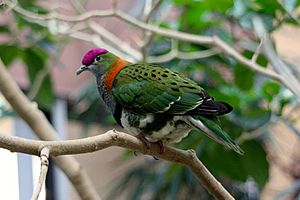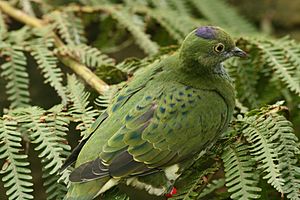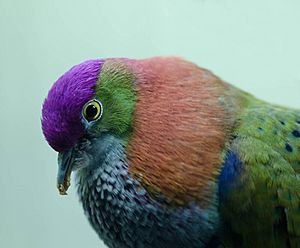Superb fruit dove facts for kids
Quick facts for kids Superb fruit dove |
|
|---|---|
 |
|
| Male at London Zoo | |
| Conservation status | |
| Scientific classification | |
| Genus: |
Ptilinopus
|
| Species: |
superbus
|
The superb fruit dove (Ptilinopus superbus) is a beautiful, medium-sized bird. It is also known as the purple-crowned fruit dove. This colourful dove is part of the Columbidae family. It grows to about 22–24 cm long.
Contents
What Does the Superb Fruit Dove Look Like?

Superb fruit doves look different depending on if they are male or female. This is called sexual dimorphism.
Males are very colourful. They have a bright orange patch on the back of their neck and green ears. Their head has a purple crown. The chest is grey, with a wide, dark blue band below it. Their wings are olive green with dark spots. The tail has a white tip.
Females are mostly green. They have a white belly and blue tips on their wings. Their chest is light blue, and they have a small, dark blue spot on the back of their head. Both male and female doves have yellow eyes and yellow rings around their eyes. Even with all their bright colours, these doves are very good at hiding in the green rainforest trees.
Where Do Superb Fruit Doves Live?
These doves are originally from Australasia. They live in the rainforests of New Guinea, Australia, the Solomon Islands, the Philippines, and Sulawesi in Indonesia.
In Australia, you can find them from southern New South Wales up to Cape York in Queensland. In some places, like the New Guinean rainforest, they live there all year. In other areas, like parts of Australia, they might move around. They travel to find food when it is available.
What Do Superb Fruit Doves Eat?
Superb fruit doves mainly eat fruits and berries. In the Port Moresby area, they mostly eat figs. This includes types like Ficus albipila and Ficus benjamina. They also enjoy fruits from Canarium australianum trees and different kinds of palm trees. These include Archontophoenix, Calamus, and Livistona palms.
They often eat fruits from various cinnamon trees, Litsea, Neolitsea, and Cryptocarya. Sometimes, they also eat fruits from Ylang-ylang (Cananga odorata), Syzygium, and Vitex cofassus. They prefer smaller fruits. The biggest fruit they can eat is about 1.7 cm across.
Behaviour and Sounds
When superb fruit doves fly, their wings make a whistling sound. Their call is a steady coo-coo-coo-coo.
Reproduction and Life Cycle
The breeding season for superb fruit doves is from September to January. The doves build a small nest made of twigs. This nest is usually high up in a tree, about 5 to 30 metres off the ground.
The female dove lays one small, white egg. She sits on the egg to keep it warm during the night. This is called incubation. The male dove takes his turn sitting on the egg during the day.
How Are Superb Fruit Doves Protected?
Losing their natural home is a big problem for these doves. However, the superb fruit dove is still quite common across its wide range. The IUCN Red List of Threatened Species lists it as least concern. This means it is not currently in danger of disappearing.
But in New South Wales, Australia, the superb fruit dove is considered vulnerable. This means it could become endangered in the future if its habitat continues to be lost.
See also
 In Spanish: Tilopo soberbio para niños
In Spanish: Tilopo soberbio para niños



